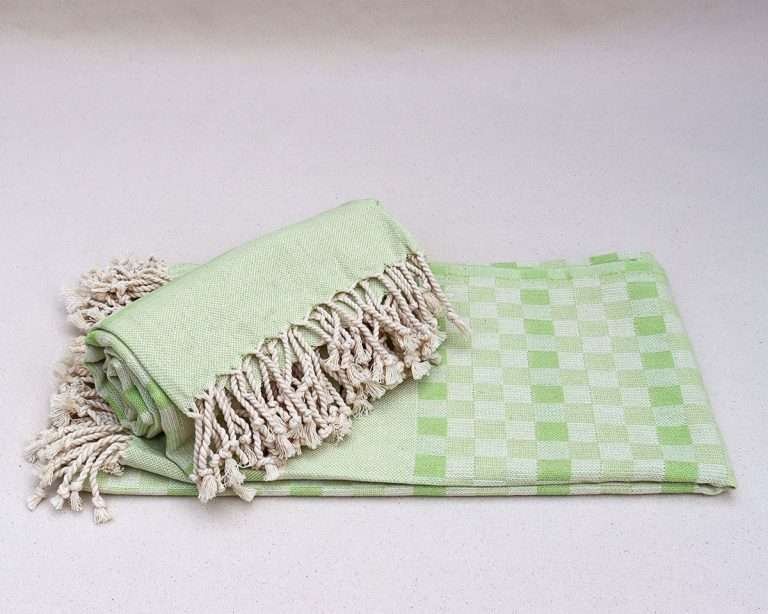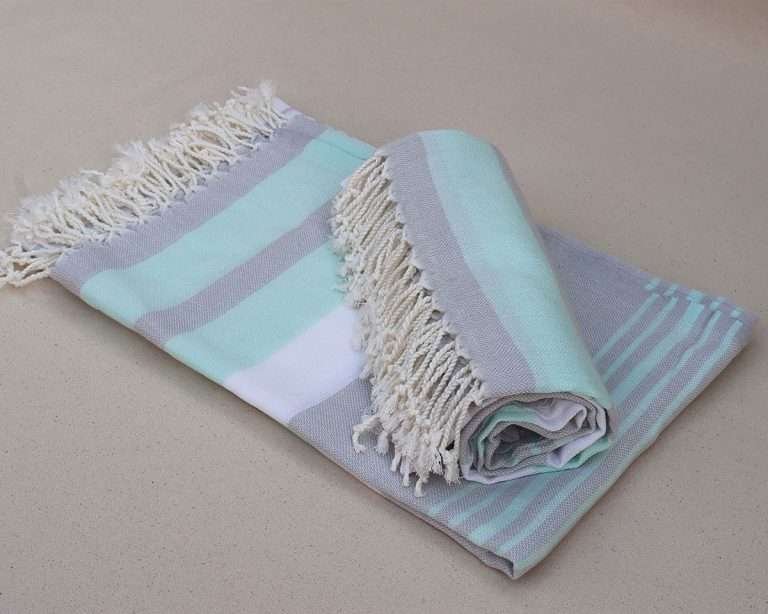When it comes to towels, two of the most popular options are Turkish towels (also known as peshtemal towels) and terry towels. But what exactly is the difference between these two towel types? And is one really better than the other?
At The Turkish Towel Company, we specialise in beautiful, high-quality handmade Turkish towels. We decided to write this blog post to help explain the key differences between Turkish and terry towels, so you can decide which option is best for your needs.
What is a Turkish Towel?
A Turkish towel, also known as a peshtemal, is a type of flatwoven cotton towel that originated in Turkey. These towels are lightweight and thin, with fringed edges on both ends.
The weave of a Turkish towel gives it a textured, almost ribbed surface. This unique weave allows the towels to be highly water absorbent while also drying very quickly – we’ll talk more about the fast drying capabilities later in this post.
Turkish towels are always 100% cotton. Traditionally they were handwoven on old-fashioned looms, but modern weaving technology can mimic this artisanal look and feel. Authentic peshtemals use only natural dyes as well.
These towels come in vivid colours and patterns reflecting Turkish culture and textile heritage. Common motifs include the evil eye, tulips, and intricate geometric designs.
What is a Terry Towel?
A terry towel is made using terrycloth, which has characteristic loops that create extra thickness and absorbency. The loops are able to soak up large amounts of water.
Terry towels can be made from cotton, bamboo, microfibres, and other materials. Cotton terry is the most common. The towels have a soft, fluffy texture that many people love.
While terry cloth can be manufactured in vibrant colours, most terry towels tend to be white or solid light colours like blue, green or beige. Terry is not as conducive to elaborate patterns and designs as the flatweave of a Turkish towel.
Absorbency Comparison
One of the biggest considerations when choosing a towel is how well it absorbs water. Let’s compare terry and Turkish towels for absorbency.
The piled loops in terry cloth trap large amounts of moisture. Terry towels tend to be very thick and plush, with excellent water-wicking capabilities.
Turkish towels have a flatter, thinner profile. However, the unique cotton weave creates ridges and valleys that absorb and disperse water quickly. The compact nature of the weave also limits how much water is retained.
For most everyday uses, both towel types absorb sufficient water when drying off after a shower or swim. Terry’s extra plushness may give it a slight edge for absorbency, but Turkish towels are surprisingly effective given their thinner structure.
Drying Time Comparison
After you dry off, you want the towel to dry quickly so it’s ready for the next use. Let’s see how terry and Turkish towels compare for fast drying.
The compact weave and thinner profile of Turkish towels allow them to dry extremely quickly. In fact, most authentic handwoven peshtemals will dry in just a few hours. The flatweave doesn’t retain much moisture.
The thick, piled terry loops take considerably longer to dry out. A terry towel may take 24 hours or longer to fully dry after use. The moisture gets trapped in the piles.
For this reason, Turkish towels have a clear advantage when it comes to drying speed. Their fast drying capability makes them much more convenient when you need a towel to use repeatedly.
Weight and Portability
On top of quick drying, Turkish towels are prized for their lightweight, portable nature.
The flatweave cotton and thinner structure mean Turkish towels are very lightweight. An authentic peshtemal can weigh as little as 100 grams.
This makes them ideal for travel, camping, beach days, yoga class, and other activities where you want a towel that won’t weigh down your bag. Terry towels are noticeably heavier and bulkier in comparison.
When rolled or folded up, Turkish towels remain highly compact. You can easily tuck them into a purse or backpack. Again, the slim profile is much easier to transport than thick terry towels.
Stylish Designs and Patterns
One area where Turkish towels clearly stand out is the designs and patterns.
The handwoven flatweave style lends itself beautifully to creating colourful, stylish motifs. Traditional Turkish patterns and symbols make peshtemals into works of art.
Terry cloth is not as conducive to elaborate designs. Solid colours and basic stripes or checks are the norm.
For those who appreciate unique, artisanal style, the vibrant patterns and heritage designs are a huge benefit of Turkish towels. They add a decorative flair whether used in the bathroom, kitchen or elsewhere.
Durability Comparison
For a towel you’ll use daily, durability is important. Let’s see how these two towel types compare.
The dense, flatweave texture of Turkish towels makes them very durable. The tight construction resists fraying or tearing. With proper care, a peshtemal can last for years or even decades.
Terry cloth has all those little loops that can get pulled or snagged over time. Terry towels tend to fray, pill or thin out more rapidly than Turkish towels.
However, both towels will have a longer lifespan if you launder them properly and avoid harsh chemicals. Choosing 100% cotton also improves durability.
Price Differences
What about the cost difference between terry and Turkish towels?
An average terry towel costs $5 to $30 based on size, materials and quality. They are widely mass produced.
Authentic handwoven Turkish towels take more time and skill to create, so they are priced higher. Expect to pay $30 to $100 for a high-quality peshtemal.
The artisanal heritage and decorative nature of Turkish towels accounts for the increased price. But many customers find them a worthwhile investment to enjoy for years.
The Verdict: Turkish Towels vs Terry Towels
So what’s the final verdict – are Turkish towels better than terry towels?
While terry cloth has some benefits like plush thickness and moisture absorption, overall Turkish towels come out ahead in many regards.
Key advantages of Turkish towels include:
- Ultra quick drying time
- Lightweight and highly portable design
- Vibrant patterns and decorative styles
- Excellent durability
Experience Turkish Towels for Yourself
We hope this article has helped highlight the key differences between Turkish and terry towels. It’s easy to see why traditional Turkish towels offer so many benefits thanks to their unique weaving style.
At The Turkish Towel Company, we specialize in bringing you authentic, high-quality peshtemals crafted using traditional techniques. Our towels are handwoven from 100% Turkish cotton using natural dyes.
Browse our online shop to find beautiful Turkish towels in a range of colors and designs.
Our lightweight, quick-drying towels are perfect for travel, camping, the beach, yoga, and everyday use. We even sell extra large peshtemals for use as beach blankets or picnic rugs.
Every purchase supports artisans in Turkey who handweave these special towels using centuries-old methods. Your order helps keep the tradition alive.
Ready to experience the beauty and versatility of genuine Turkish towels? Visit the shop today to get your own authentic peshtemals.
We offer free delivery Australia-wide and satisfaction guaranteed. You’ll love the quality and heritage behind our unique products. Discover the magic of Turkish towels today!


